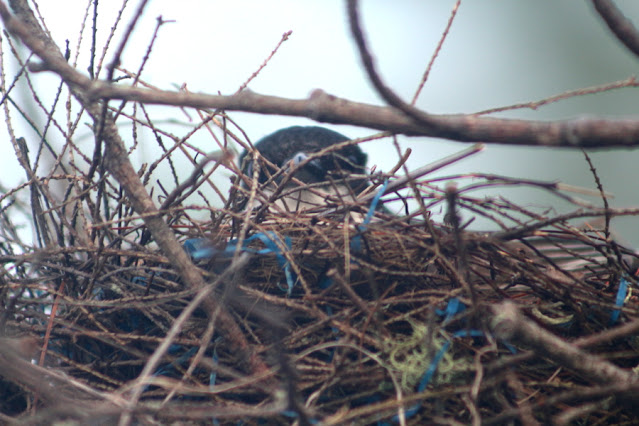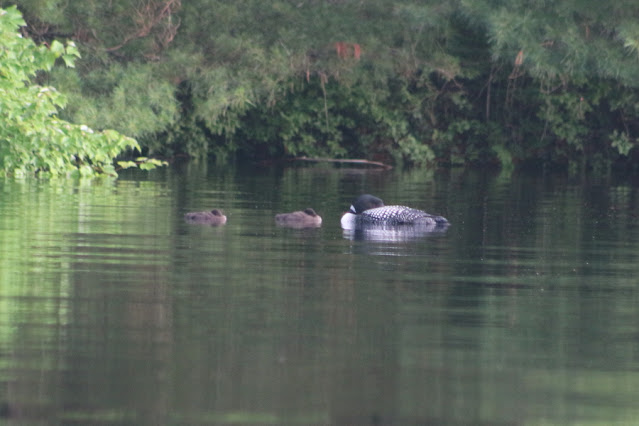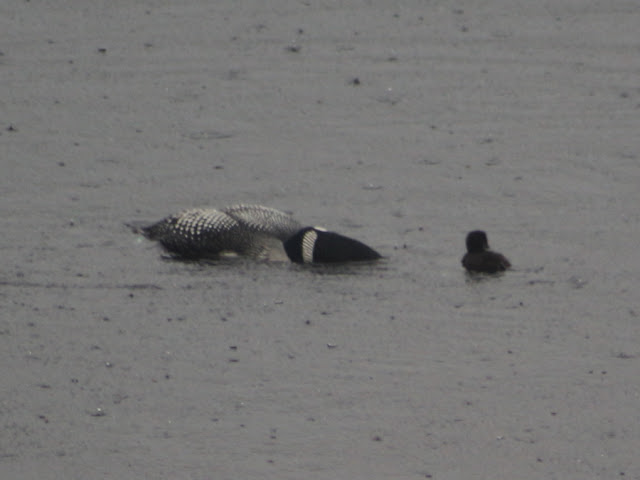The Lake Wicwas Association held their annual Paddle Regatta and Barbeque yesterday, once again graciously hosted by the Blakes, and the weather was kind enough to allow both events to take place without anyone getting wet.
 |
| The regatta departs from Wedding Island under the expert guidance of Dean Cascadden. |
 |
| Navigating Blake Brook. |
 |
Exploring the beaver dam.
Photos by Dean Cascadden. |
Later at the barbeque, food and conversation were great as always and it was wonderful to catch up with everyone after missing out last year.

 |
| Always great food! |
 |
| That's Master Chef Wayne under the tent cooking up those perfect burgers. |
Second only to seeing everyone was getting a demonstration of Wayne's sawmill.
 |
| Wayne Saws a 1938 hurricane log. |
He gave a demonstration by sawing one of the Hurricane of '38 logs that was retrieved from the lake and dried out for weeks. This particular log had an "S" stamped in it; there was discussion of whether this stood for the US Forest Service or logger Joseph Smith. (My money is on Smith!) Wayne has a number of boards he has sawn from these ancient logs and has a few he would offer to someone who wants one for a project - contact me if you're interested. For more of the history on these sunken logs, see this prior post.
A warm welcome to the new members of the association, and a huge thank you to the Blakes!
Earlier in the day the Loon Preservation Committee held their state-wide loon census from 8:00 to 9:00 and Lake Wicwas had four people combing the lake for loons. Dave and Marge Thorpe found a group of six loons carousing together in the southern portion of the lake, while Michael Marion and I found the family of mom, dad, Coco, and Jimmy, for a total of ten loons on our small lake - that may be record for our census day.
 |
| The Wicwas Navy steams up the lake. |
While we watched the family of four, mom came up with a large fish - we know it was mom because we saw her red band.
 |
| Mom brings home the bacon this morning. |
She first brought it to one chick who wanted nothing to do with it.
Usually when a parent comes up with a fish both chicks go rushing over to get it first, but not for this monster fish (from a chicks' perspective). Mom went back and forth between the two of them several times, but each time the chick turned up their nose.
Or should I say, stuck its head in the water.
Eventually mom gave up and swallowed it herself - it was pretty big even for her.
 |
| Look at that bulge in her neck. |
While she was trying to convince someone to eat it dad came up with a chick-size minnow, and sure enough, Jimmy dashed right over and gobbled it down!
 |
| Dad motors off in search of more. |
Here's yet another surprising nature report from Lake Wicwas. First you need to know that the Thorpes have a statue of heron on their property. They've long wondered if they'd ever see a real heron come to visit it. Well earlier this summer it actually happened.
 |
| Henry and Henrietta. Photo by Dave Thorpe. |
The statue is Henry, and they named its friend Henrietta. Once Henrietta found a companion she decided to come back and visit again, but on the most recent visit the Thorpes witnessed something extraordinary: Henrietta caught a chipmunk! They watched as the heron thrashed it around for a while, either killing it or at least wearing it down; Henrietta then took off with it in her beak, presumably to feed it to her chicks back in the nest. [That's a correction from the original post.] But the crazy heron stories don't end there.
On another day Debby Crowley was watching a loon on the lake when she saw another bird land. When she zoomed in on it she saw it was a heron. Have you ever seen a heron land on the water? She then saw it had a fish in it's beak - it's unknow if the heron caught it or saw it floating on the water and came down to get it. Either way it decided to leave it there as its neck was already pretty full - heron will catch food and store it in their neck to bring it to the chicks in the nest for feeding.
I asked Debby if the heron was able to fly away from deep water and she said yes, actually rather gracefully, and even sent some photos of the takeoff.
 |
| Flaps out. |
 |
| Gaining air speed. |
 |
| Almost there. |
 |
Airborne - retract landing gear.
Photos by Debby Crowley. |
Nature never ceases to surprise me with its unexpected events. Thank you for those great nature reports Dave and Debby!
One thing that has come to be expected this July is rain. One evening after a rather wet day the sky cleared enough to go out for a quiet evening paddle, and like most days, even rainy ones, there's always something beautiful to see in the world.
 |
| Rain drops on lily pads. |
 |
| Mist rises from the hills beyond Wicwas. |



































































